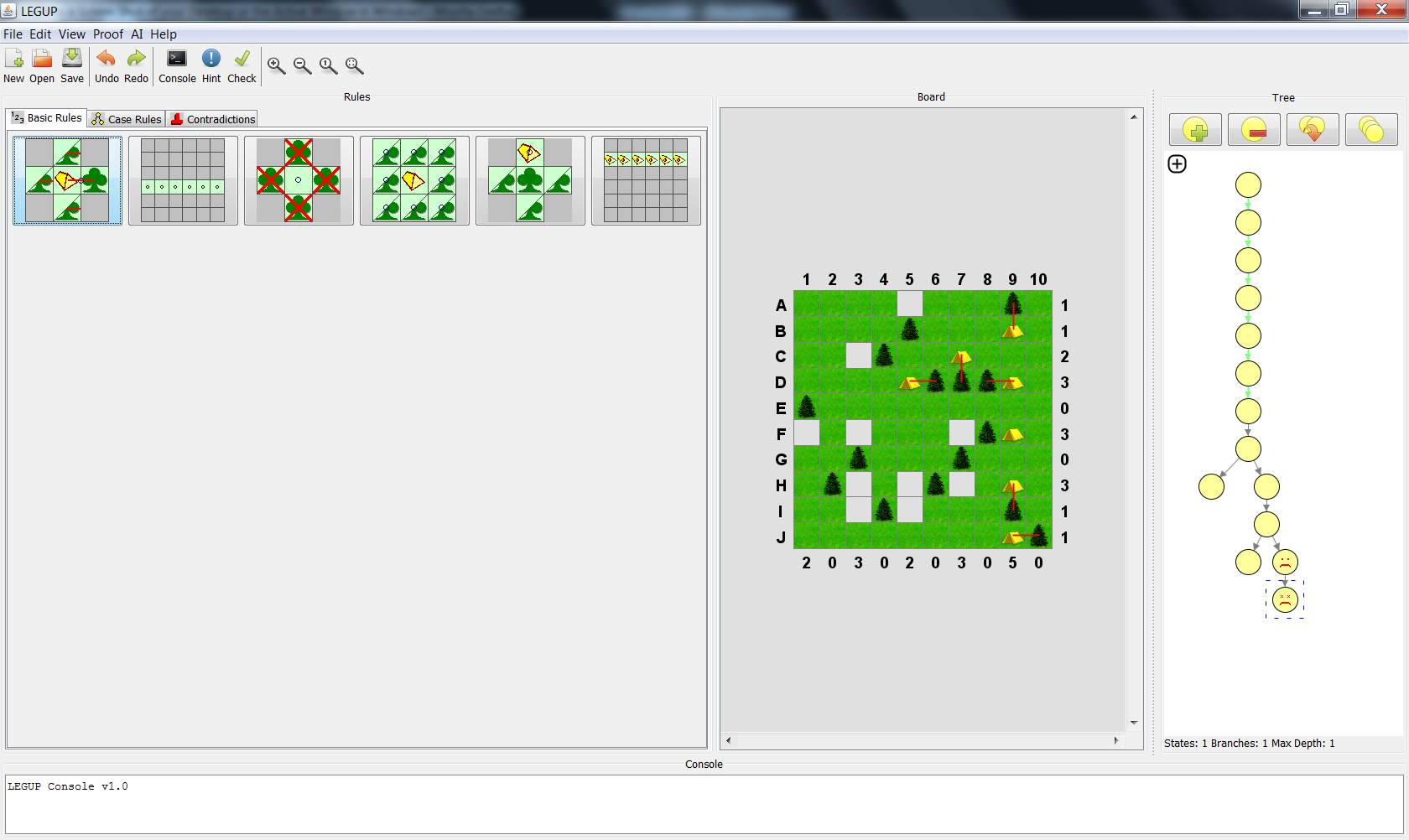Introduction
LEGUP (Logic Engine for Grid-Using Puzzles) is an Undergraduate Research Project under the supervision of Dr. Bram van Heuveln in the Department of Cognitive Science. It is an example of Dr. van Heuveln's general research in Visual Logic, which involves systems of logic based on visual representations.
The main goal of the LEGUP project is to provide a better interface for students to learn basic principles of logical reasoning. Dr. van Heuveln has taught logic courses on a frequent basis for the past 15 years, and noted that a good number of students struggle with the systems of modern formal logic that were developed in the late 1800's and early 1900's, and that have been universally used in logic courses since. These traditional systems use abstract linear symbol strings such as (P & Q) -> (R v S), and deploy even more abstract rules such as & Elim to infer new symbol strings from old ones, thus engaging the user in logical reasoning. However, Dr. van Heuveln believes that there are more pedagogically effective ways for students to learn the basic and important principles of logical reasoning. The development of such a system and interface is the focus of the LEGUP project. In particular, the LEGUP system uses more visual representations in a more concrete and engaging environment. These and other features of the LEGUP interface are suspected to have several advantages over more traditional interfaces in terms of learning logic. For more detail on the suspected pedagogical virtues of the LEGUP project, and the various assumptions behind them, please read the Intellectual Background section.
The LEGUP interface allows the user to solve different types of grid-based logical puzzles. Probably the best known example of such a puzzle is the popular Sudoku puzzle, but there are many other types of puzzles that are based on the principle of filling in cells of a square or rectangular grid with different kinds of objects. In all cases, the user is provided certain clues that will force a unique configuration of objects in the grid. Indeed, these types of puzzles are often advertised as 'logic puzzles', and are claimed to train one's logical mind as, using deduction, users should be able to infer which object goes where. Moreover, there are many online applets for such puzzle available, some of which can be found on our Links page. So, how does the LEGUP interface differ from those? The most important difference is that the LEGUP interface requires the user to explicitly indicate their logical reasoning. Thus, solving the puzzle due to some lucky guesses is no longer an option in LEGUP! Indeed, the interface will congratulate the user less on the fact that the user was able to solve the puzzle, but more on how the user solved the puzzle. This, of course, is essential to logic: logic is not about the truth or the correct or best answer, but about deductive implication and valid inference: what follows from what, and why?! Second, LEGUP provides a single interface that is capable of supporting many different types of puzzles. Since most of the interface remains the same, however, users wil start to recognize certain similarities between the different puzzles. In particular, since they have to explicitly state their reasoning, users should start to see strong similarities in their logical reasoning patterns from puzzle to puzzle, which is the very basis of the abstract logical reasoning principles taught in traditional logic courses. However, rather than being 'thrown in the water' with abstract principles based on obscure symbols, users instead are dealing with a concrete, fun, and engaging logic puzzle. As such, LEGUP aims to give its users a 'leg up' when it comes to the understanding of logic.
Will the LEGUP project really teach logic in a more effective manner than more traditional systems? A very small and preliminary study that we ran suggests that it does. This and other experiments can be read about on the Experiments page. Ultimately, Dr. van Heuveln aims to use the interface in his logic courses, and run a large scale experiment to find out about its educational impact. Currently, much of the interface is in place, and the user can solve puzzles of various different types. However, some improvements still need to be made to really support the natural 'cognitive flow' of reasoning. Finally, Dr. van Heuveln is always looking for some smart people to further develop the LEGUP interface. If you like doing logic puzzles, you can help by further researching different logic puzzles as listed on the Researched Puzzles page. If you like to help out with programming, and are good with Java or GUI development, or are otherwise interested in helping out, please contact Dr. Bram van Heuveln.
